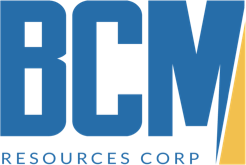Vancouver, BC, February 8, 2023 – BCM Resources Corp ("B" or the "Company") would like to update its shareholders about the advances in its exploration drilling program at Thompson Knolls (TK) greenfield Cu-Au-Ag-Mo porphyry system in southwestern Utah, USA. Diamond drilling is successfully advancing drill testing of the deep porphyry and skarn targets previously described in the Company press release dated October 12, 2022. The greenfield TK Cu-Au-Ag-Mo porphyry project is located approximately 210 km southwest of Rio Tinto’s giant Bingham Canyon porphyry copper-molybdenum-gold mine and smelter complex near Salt Lake City, Utah. It is accessed by a highway and then by a network of gravel roads.
President Dr. Sergei Diakov stated "We continue advancing our Phase 3 drilling program with two drill holes recently completed and a third hole in progress. Drilling intercepted mineralization in the porphyry intrusion and surrounding skarns beneath the post-mineral cover. A significant skarn intercept in hole TK8, with a strong presence of sulfide mineralization, is very encouraging. We are looking forward to potentially exciting results from this drilling program."
TK8 drill hole (completed, but failed to reach target depth). This hole was vertical (90 degrees) and located on the mineralized trend from drill holes TK1, TK3a & TK5 (Fig 2 in Exploration Drilling Update on BCM website BCM Resources Corp. | Presentations). Hole TK8 had a projected target depth of 4,000 ft (1,220m). The drill hole crossed a 1,484 ft-thick (452 m) post-mineral fanglomerate cover and then encountered a package of limestones, mudstones, and sandstones. Significantly, the limestones contain a well-developed diopside-marble skarn. The upper parts of this skarn are oxidized, then farther into the skarn drilling encountered a very intense sulfide-rich magnetite breccia in skarns stretching for over a 1,021.5 ft (313 m) interval. Locally, sulfide mineralization consists of pyrite (avg 10%)-pyrrhotite (avg 8%)-chalcopyrite (avg 5%) and is developed as clots/patches within massive magnetite breccias and in halos as disseminated mineralization. Unfortunately, after encountering a fault zone at depth of 3,021.5 ft (921 m) drillers lost the hole. The bottom of the hole was still in good skarn mineralization with its extension remaining open in all directions. The contact between the skarn and porphyry intrusion has not been tested and remains a compelling target.
TK7 drill hole was also drilled vertically (90 degrees) through a 1,250 ft thick (381 m) post-mineral cover unit of semi-consolidated fanglomerates with numerous sandy horizons, which presented a significant drilling challenge. Below the fanglomerates, drilling intersected mineralized quartz-monzonite porphyry (QMP) intrusion until the end of the hole. The QMP unit has three alteration types: i) illite-chlorite (propylitic); ii) quartz-sericite-pyritic (QSP) alteration (phyllic), and; iii) patchy biotite-K feldspar (potassic). Mineralization is documented as poorly mineralized quartz-pyrite-chalcopyrite stockwork veining and disseminated mineralization. Drilling of TK7 was stopped in a fault zone at depth of 2,641 ft (804.98 m).
We are currently advancing TK9 drill hole, which is expected to test the possible eastern extension of well-mineralized skarn at TK6.
Drill core with mineralization is being cut by a diamond saw and sample preparation for the mineralized intervals is underway. Assaying for standard ICP and gold fire assay package will be done at ALS Global.
The Company is planning to expand the scope of its exploration program at TK in 2023. To accommodate this larger program, we have prepared a Plan of Operation (PoO) and submitted the proposal to Utah BLM and the Utah Division of Oil, Gas, and Mining for their review and approval. The proposal was accepted by both the Utah government and BLM agencies. Approval of the Plan will allow the Company to significantly increase exploration drilling testing of the northern and southern portions of the TK property.
Qualified Person
The Company’s Director, Mr. Richard R. Redfern, M.Sc., and Certified Professional Geologist, a "qualified person" for the purposes of National Instrument 43-101, has verified and approved the information contained in this news release.
About BCM Resources Corporation
BCM Resources Corporation is a diversified Canadian mineral exploration company focused on the continued exploration of the Thompson Knolls Porphyry Cu-Au-Mo project. BCM also controls prospective Copper, Gold, and Molybdenum exploration projects in British Columbia. BCM Resources is managed by experienced and successful board members and advisors. For further information, including area maps, sections, and photos, please visit our website at www.bcmresources.com or contact us by e-mail at info@bcmresources.com.
ON BEHALF OF BCM RESOURCES CORP.
Dr. Sergei Diakov
President & Director
For further information, please contact:
Investor relations 604-646-0144 ext. 222
info@bcmresources.com
www.bcmresources.com
Caution Concerning Forward-Looking Statements:
This news release and related texts and images on BCM Resource Corporation’s website contain certain "forward-looking statements" including, but not limited to, statements relating to interpretation of mineralization potential, drilling and assay results, future exploration work, and the anticipated results of this work. Forward-looking statements are statements that are not historical facts and are subject to a variety of risks and uncertainties which could cause actual events or results to differ materially from those reflected in the forward-looking statements, including, without limitation: risks related to fluctuations in metals prices; uncertainties related to raising sufficient financing to fund the planned work in a timely manner and on acceptable terms; changes in planned work resulting from weather, logistical, technical, governmental, social, or other factors; the possibility that results of work will not fulfill expectations and realize the perceived potential of the company’s projects; uncertainties involved in the interpretation of sampling and drilling results and other tests; the possibility that required permits and access agreements may not be obtained in a timely manner; risk of accidents, equipment breakdowns or other unanticipated difficulties or interruptions, and; the possibility of cost overruns or unanticipated expenses in these exploration programs.
